
The term 'Plants' covers a huge range of subjects as far as gardening is concerned. All plants have a few things in common. They need to be planted in the right place, need feeding and watering, and need our help when sick! Many types of plants have their own section within this website. Roses, herbs, grasses, perennials, indoor plants, shrubs and aquatic plants for starters! Whilst there are these specialists section about certain types of plants, we feel that there is a need for this section that simply crosses the boundaries of specialism in order to bring you the easiest way to find what you are looking for by way of plants generally.
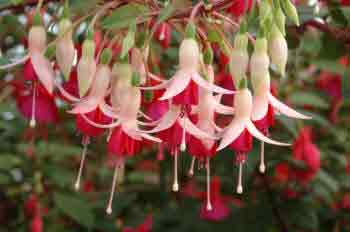
Fuchia
For instance, when describing Climbing Plants, we would need to point you to at least two different sections - Shrubs and Perennials.
Ground cover plants are to be found in a number of different sections - shrubs, grasses, perennials, alpines and ferns - to name a few.
So to make things easier - and to help you find the widest range of plants for your garden - Plants is now a dedicated section within the site
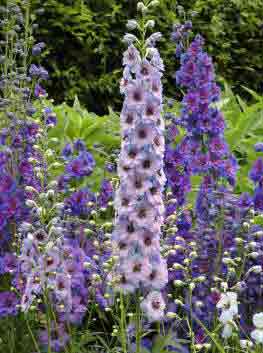
Delphiniums
The scope of this section about tall flowering plants includes those that either have tall flower spikes rising above non-intrusive foliage, or those that have flowers atop slender erect stems. For the most part, shrubs will be excluded – having a section of their own – together with perennial plants that have substantial foliage where the flowers are not held considerable aloof of the leaf canopy. We talk of tall flowers rather than big plants!
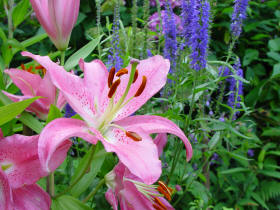
That seems an innocent and basic question which, in an ideal simple life, can be answered easily. A plant is a living thing that grows in the ground, has roots, stems, branches, leaves, flowers, and fruit or berries”. That answer covers the basics, but there is more – much more – to be added if we are to fully describe what a plant is – and in particular all the component parts that combine to make up the plant kingdom – Plantae.

Root System
The roots of a plant are normally below ground – out of sight and generally out of mind. Little is known about the actual purpose or the structure of plants root system and it is generally the last area of interest when trying to discover why a plant is ailing. As it happens, more often than not plant roots fare better than other parts in relation to diseases and pests.
Garden Plants and Flowers Listed A - Z, you can browse through Alphabetically and use it as a gallery. If you know the name you can use the search.

Irish Bells Seedheads
Deadheading flowers on plants is done for a variety of reasons. As you would expect, not all plants are deadheaded the same way if at all - nor for the same reasons. For instance deadheading a rose is not the same as deadheading a pansy. There are several basic reasons why you should take the faded flowers off plants, and there are several ways in which to do it according to plant. Some plants are better not deadheaded!
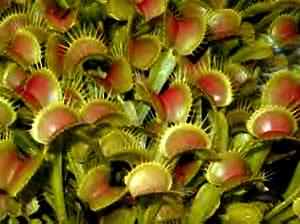
Venus Fly Trap
Are plants more than just vegetables? Do plants have feelings? They respond to touch; stroke them and they feel it! All plants are able to move; it may be the simple (?) movement as the plant grows, or it can be a rapid snapping shut of leaves on plants such as the Venus Fly Trap (Dionaea muscipula)!
Another 'mover' is the Sundew (Drosera). In this case, the leaves have 'tentacles' which close in on the prey once the prey becomes trapped in the dewy substance on the leaves.

Pernettya
Most plants are produced by some form of sexual activity; generally referred to as sexual propagation. As with animals, there is generally a male and female involved in the reproductive process, but unlike animals – and humans – some plant species can forego the basics of sex and simply ‘grow’ an additional youngster somewhere on their being. The equivalent to a permanent headache!
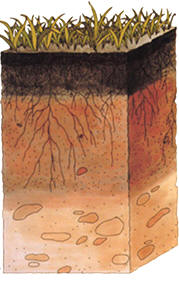
Soil System
It is easy to forget - or not realise - that plants are living things. As such, they have specific care requirements - just the same as us humans - to grow properly!
In order to grow healthy plants in your garden - or in your house - you need to fulfil just a few requirements that plants require in order to remain in good condition.
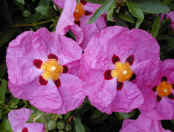
Cistus Flowers
Plants for dry areas and plants for dry banks, in the garden will become increasingly popular once the cost of water rises higher.
A meter is required if a sprinkler is used in most areas. Dry areas and dry banks can be colourful and maintenance free -with the right choice of plants!
Once established, there is no reason why your bank should not look like any other part of your garden - many flowers atop lush foliage. But, it does need the correct choice of plants

Azal Flowers
Many plants will grow in shady areas of the garden - some with quite spectacular flowers. Shaded areas can be bought to life - if you use the right plants.
Shade from house walls can mean either dry or damp, depending upon which aspect of the wall. North facing will be cold and often damp, whereas the South facing wall will normally be dry - for summer at least. For summer bedding plants, you cannot beat the ordinary Busy Lizzie (Impatiens) for shaded areas - and they don’t come much prettier than that.
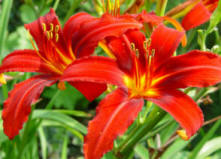
Hemerocallis Flowers
Plants and shrubs that will grow in Damp conditions. (Those areas that are damp underfoot, but not so wet as to sink in!) Many plants will grow in either permanently damp - or permanently dry conditions. For instance the Day Lilies - Hemerocallis are normally associated with 'normal' or dry soil situations.
They are often used in mixed or perennial borders, but the best display I have seen were growing in very damp conditions - at the edge of a large natural lake. Roots in water for most of the time. Similarly, the Lobelia cardinalis types are happy wet or dry!
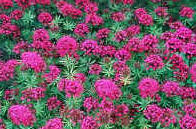
Phuopsis Flowers
There are conflicting reports as to how 'global warming' - if it happens - will affect the UK - in particular the gardens, suffering from dry conditions. Recent reports have been telling of the rise in temperature, that will bring us dry near-Mediterranean garden conditions, with flower beds and borders in our gardens resembling those of the dry gardens of the world.
But there is also a school of thought that says that the gulf stream will move south, and not bless our western coastline with its warm waters. If this happens, we will lose a few degrees pretty quick. Whichever, there will be a dramatic change in how we plant and look after our gardens.
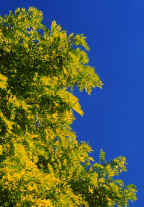
Subsidence
Subsidence occurs when the (clay) soil under the building foundations shrinks; thereby leaving the walls without proper support. The building will then drop, and cracks may appear in the walls.
The ‘shrinking’ and ‘heaving’ of the soil may be a result of the seasonal variations in ground water levels. Extremely dry summers often make the problem of house subsidence worse.
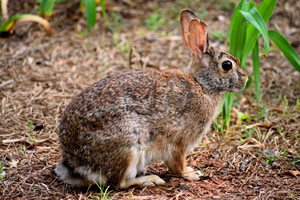
Rabbit
The following plants are said to be 'Rabbit proof' or rabbit resistant. Much will depend on the stage of growth. For instance, Geraniums are listed, but young growth may be 'attacked'!
It seems that much depends upon what part of the country you live determines whether or not a certain plant will be resistant to Rabbit damage.
This list is drawn up from personal experience - mainly in South East England, in a wide range of garden situations. Some of the subjects I have planted in other gardens - and of course met with failure!

Butterfly on Lavendar
Not all 'wildlife' in the garden is undesirable! Here are just a few plants that attract birds and other wildlife into the garden.
If you have the space, then one of the Buddleja davidii types (The Butterfly Bush) will be just right - Black Knight, Empire Blue, Peace, Royal Red, Nahno Blue (shown) and Harlequin are all good ones. A good selection od native plants would also help - providing nectar and shelter to a wide range of insects.

Moluccella
Deadheading flowers on plants is done for a variety of reasons. As you would expect, not all plants are deadheaded the same way if at all - nor for the same reasons. For instance deadheading a rose is not the same as deadheading a pansy. There are several basic reasons why you should take the faded flowers off plants, and there are several ways in which to do it according to plant. Some plants are better not deadheaded!

Bedding Plants
A Bedding Plant is a flowering plant that is used in the garden to give a few months’ display of colour. It can be planted in a flower bed, a border or even a container/hanging basket.
Most bedding plants are used for either summer or spring flowering. Some, such as Pansies, will give a bit of colour through the winter as well.
Bedding plants can be used between existing mature plants such as shrubs and Perennials. Bedding Plants are normally take out after flowering and either composted or put in the rubbish bin.
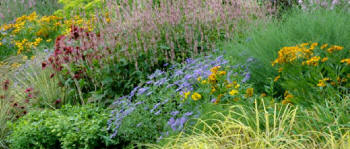
Ground Cover Plants
Ground cover plants are often wrongly sold or advertised as being the sole solution to weeds in some areas of the garden. In this and the following list of ground cover plants, we talk only about those that are true weed suppressing plants once established. Many articles simply include space fillers. Different!
Not all of the plants that are sold as ground cover are up to the job. There are two basic types of groundcover. The first is for creating a carpet of plants which are important in the 'garden' sense. The second is 'Utopia' - so often sought, but rarely found - the complete smothering of weeds - without any added effort. Huh!

Cistus Flowers
Don't get completely carried away with flowers when you are choosing plants and shrubs for your garden. There are some plants with spectacular foliage as well. Bear in mind that plants with ornamental foliage will often have a longer period of interest than flowers!
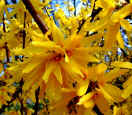
Forsythia Flowers
Yellow flowering plants are generally not known or popular for their scent - though many have slight fragrance. We list here, most of the common yellow flowered plants and exclude some of the rather more specialised plants such as the Yellow Flowered Magnolia Yellow Fever, Yellow River, Canarybird and the like.
This list of plants with yellow flowers is set to run for a long time. If we omit your favourite - then please let us know! we will be please to add any that have genuine yellow flowers. Roses - which have their own specific section on this site - of course have hundreds of different varieties/cultivars with yellow flowers.
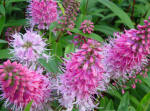
Hebe Speciosum
For your garden planning. There are many different hues of pink - more so than any other colour. Many will argue that a certain pink is cerise, blush, rose or whatever. You can decide for yourselves!
Pink flowered shrubs and plants with pink flowers will do much to 'warm up' an otherwise dull corner. Most of the substantial pink flowering shrubs and perennials flower either late spring or into summer.
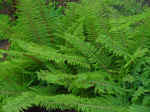
Polystichum Setiferum Divisilobum
Ferns or Pteridophytes, are amongst the most widely used foliage plants. They are generally all hardy, except for tropical species, which need a cool frost free greenhouse or an indoor site. Ferns add height to planting schemes and give an architectural form to a border. The right fern in the right spot can make a shaded area light up. Ferns are generally used in area's where other plants will not grow, heavy shade, damp soil, little top soil and even dry shade.
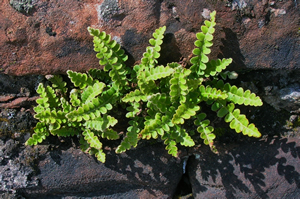
Rusty Back Fern
There is a fern for every spot in the garden, some are frost tender and will blacken at the slightest frost.
If you want hardy ferns for the garden, then you have to look for ferns that grow in similar habitats to whatever climates you have. Therefore in the UK there are many native ferns that are very hardy and a lot of varieties have been bred for their garden use.
The majority of hardy garden ferns like, water and humus rich soils, but not all!
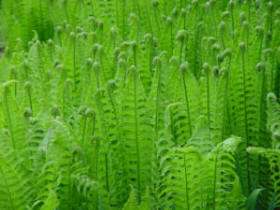
Matteuccia Struthiopteris
There is a mistaken belief that all ferns are happiest in shaded parts of the garden. Some are most certainly not, whilst others can put up with half sun and half shade – dappled shade.
This list will give you some ideas for best ferns in the different shade areas of the garden – dry shade and damp shade
Our best selection of shade loving ferns includes both evergreen and deciduous ferns. Many are suited for growing in containers – the evergreens are particularly useful for this. All ferns are happy in association with other groups of plants – shrubs and perennials if the soil conditions are suitable.

viola
Winter flowering pansies and violas are by far the best option for surefire flower power in the winter months. They need little in the way of care, but there are several points to bear in mind in order to get the best show of flowers through the winter.
Universal winter pansies were the first real winter flowering plant to be worthy of the name, though several, types of Violas have always been food for a bit of winter cheer. The brand name of universal pansies will be withdrawn for some reason this year - 2014 - so there might be a little confusion as to what us really a winter pansy.
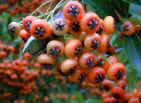
Berry Christmas
Shrubs have berries for a reason. They are an vital part of the plant's reproductive method. Berries are eaten by birds or animals, who are only interested in the juicy fleshy part of the berry. After eating the berry, the animals wander off to other areas, and eventually deposit the seed part of the berry, which has not been digested in the stomach, so passed through the body in the normal way.
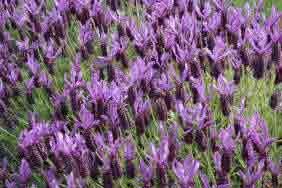
Lavenders
There are a few simple rules to ensure success with growing Lavender. Follow our advice and read the information and you will be able to grow great lavenders.
In the UK, long term success is ensured if you use the 'traditional' English lavenders - in particular, the varieties (cultivars) of Lavandula angustifolia - The English Lavender is best for growing in the UK - Much hardier!
Pruning Shrubs
The importance of pruning shrubs at the right time of year cannot be overstressed. If you prune some shrubs in the autumn, then you could be cutting off all of the next year's flower buds.
If you prune other shrubs in the spring, then the same goes. You could be cutting off the summer's flower buds. In either case, it means no flowers on your shrub!
Timing of pruning is the most important aspect for success. That is why we have put up a When to Prune Shrubs page. You can also follow our A-Z listings below for best advice on how and when to prune shrubs.

Berry Christmas
Clematis are hugely popular here in the UK – and rightly so, for it is possible to have clematis on flower for most months of the year. Together with that, several of the clematis varieties have attractive seedheads that are on the plant well into the winter months – and can be quite a feature, if planted where the winter sun is behind.

Assorted Containers
Container gardening - or growing plants in pots - has seen a huge increase in popularity during the last ten years. The reasons for the increased popularity of growing plants in pots are many and varied. Container compost for pot grown plants have improved; the range of plants available for containers has increased; container gardening it is an 'easy' way to garden; you can have colourful plants nearer to the house etc
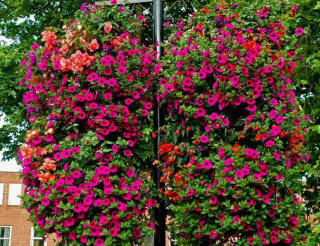
The Chocolate Vine
Window box and hanging basket gardening can be done by almost anyone. It is probably the most versatile and rewarding use of space - other than possibly 'vertical' gardening. Even then, window boxes can be included in a wall garden. Using boxes and containers is a good way to produce flower - and fruit and veg - if you are short of garden space.
The main thing that window boxes and hanging baskets have in common, is the fact that they generally have a smaller amount of soil for the plants to grow in than do normal patio pots - or of course the garden proper. This minimal amount of soil, then leads us to planting many of the same plant types in both hanging baskets and window boxes. Often when planting up for the spring or autumn, there is a choice to be made for a 'special' plant - box or basket!
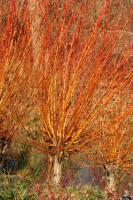
Sango Kaku
When planting/designing a garden or flower bed, always take into account the effects that sunlight direction can have - especially the low angular sunlight of the winter months.
Plant subjects with interesting seed heads etc where they can be fully highlighted and appreciated with the sun shining through from the rear. If they can be planted against a dark background - so much the better.
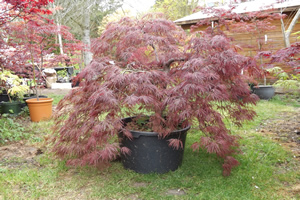
Acer Trees
Acer Trees / Japanese Maples are ideal for the Patio and the edge of a Pond. Acer trees live very happily in pots and containers for 30 - 40 years.
Acers vibrant colours from their ever changing leaves and colourful barks makes them the United Kingdoms favourite plants.
Acers grow to the size of their pots, if you want to keep them small, keep them in a small pot.
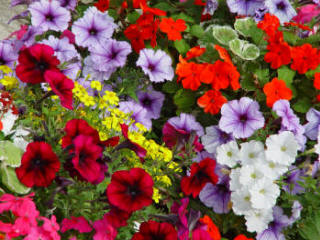
Assorted Petunias
It is always good to try to get height in a hanging basket, but also think of the fact that your hanging basket will normally be seen from below, so trailing and low plants are also important for a successful hanging basket. Good plants for centrepiece height include geraniums and bush fuchsias.
I like to plant one of each. Both geraniums and fuchsias will grow up through the chains of the basket, which in turn will help to support them. Down a level from this and you can plant a wide range of bedding plants around the centre of the hanging basket. They will grow upwards and outward and can include plants such as petunias, marigolds, tuberous begonias, busy lizzies. In fact anything that you would normally plant for mid height bedding.
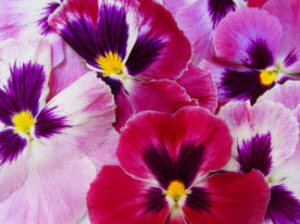
Winter Pansy flowers
Winter need not be a dull period for garden colour. Window boxes and hanging baskets can be planted up with colourful Flowers and plants to fill the gap.
Hanging baskets normally take a bit of punishment in the winter owing to windswept situations on house walls, and surprisingly drying out after not being watered!
Windy conditions, such as we normally get in the winter, will dry the compost out almost as quickly as a hot summer day - and will give your flowers a bit of a bashing! Place the basket or window box in the most sheltered position - but with plenty of light. Try to avoid those places under a bay window overhang etc.